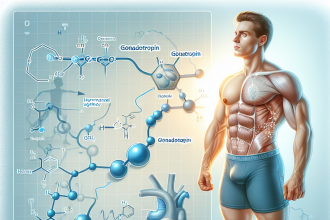-
Table of Contents
Nandrolone in Sports: A Growing Concern
The use of performance-enhancing drugs (PEDs) in sports has been a controversial topic for decades. Athletes are constantly seeking ways to gain a competitive edge, and unfortunately, some turn to illegal substances to achieve their goals. One such substance that has been gaining attention in the world of sports is nandrolone. This anabolic steroid has been linked to numerous cases of doping in various sports, raising concerns about its widespread use and potential health risks. In this article, we will explore the pharmacology of nandrolone, its effects on athletic performance, and the growing concern surrounding its use in sports.
What is Nandrolone?
Nandrolone, also known as 19-nortestosterone, is a synthetic anabolic steroid derived from testosterone. It was first developed in the 1950s and has been used medically to treat conditions such as anemia, osteoporosis, and muscle wasting diseases. However, due to its anabolic properties, it has also become a popular drug among athletes looking to enhance their performance.
Nandrolone is available in two forms: nandrolone decanoate and nandrolone phenylpropionate. The former has a longer half-life and is commonly used in medical settings, while the latter has a shorter half-life and is more commonly used by athletes due to its faster onset of action.
Pharmacology of Nandrolone
Nandrolone works by binding to androgen receptors in the body, promoting protein synthesis and increasing muscle mass. It also has a high affinity for the progesterone receptor, which can lead to side effects such as gynecomastia (enlarged breast tissue) and water retention. Nandrolone is metabolized in the liver and excreted in the urine, with a half-life of approximately 6-8 days.
One of the unique characteristics of nandrolone is its ability to convert to dihydrotestosterone (DHT) in the body. DHT is a more potent androgen than testosterone and is responsible for the androgenic effects of nandrolone, such as increased facial and body hair growth and male pattern baldness.
Nandrolone and Athletic Performance
The use of nandrolone in sports is primarily to enhance athletic performance. It is believed that nandrolone can increase muscle mass, strength, and endurance, making it an attractive drug for athletes looking to improve their performance. However, there is limited scientific evidence to support these claims.
A study by Hartgens and Kuipers (2004) found that nandrolone did not significantly improve muscle strength or endurance in healthy individuals. Another study by Kicman (2008) also concluded that there was no evidence to support the use of nandrolone for performance enhancement in sports. These findings suggest that the perceived benefits of nandrolone may be more of a placebo effect rather than a true enhancement of athletic performance.
Despite the lack of evidence, nandrolone continues to be used by athletes in various sports, including bodybuilding, track and field, and cycling. In fact, it has been reported that nandrolone is the second most commonly detected PED in sports, after testosterone (Thevis et al. 2017).
Health Risks of Nandrolone Use
While nandrolone may not have significant performance-enhancing effects, its use in sports is still a cause for concern due to its potential health risks. Nandrolone has been linked to a range of adverse effects, including cardiovascular complications, liver damage, and psychiatric disorders.
A study by Vanberg and Atar (2010) found that nandrolone use was associated with an increased risk of cardiovascular events, such as heart attacks and strokes. This is due to the drug’s ability to increase red blood cell production, which can lead to thickening of the blood and increased risk of blood clots.
Nandrolone has also been shown to have negative effects on liver function, with reports of liver damage and tumors in individuals using the drug (Kicman 2008). Additionally, nandrolone use has been linked to psychiatric disorders, such as aggression and mood swings, which can have serious consequences for both the user and those around them.
The Growing Concern of Nandrolone Use in Sports
The use of nandrolone in sports is a growing concern due to its potential health risks and the lack of evidence to support its performance-enhancing effects. The World Anti-Doping Agency (WADA) has banned the use of nandrolone in sports, and athletes who test positive for the drug can face severe consequences, including suspension and loss of medals and titles.
However, despite these strict regulations, nandrolone use in sports continues to be a prevalent issue. In 2019, the International Association of Athletics Federations (IAAF) reported that nandrolone was the most commonly detected PED in their testing, with 37% of all positive tests being attributed to the drug (IAAF 2019).
The widespread use of nandrolone in sports not only poses a risk to the health of athletes but also undermines the integrity of fair competition. It gives an unfair advantage to those who use the drug and can discourage clean athletes from competing at the highest level.
Conclusion
Nandrolone is a synthetic anabolic steroid that has gained popularity among athletes looking to enhance their performance. However, there is limited evidence to support its performance-enhancing effects, and its use in sports is a growing concern due to its potential health risks. The widespread use of nandrolone not only poses a threat to the health of athletes but also undermines the integrity of fair competition. It is crucial for sports organizations and governing bodies to continue their efforts in detecting and deterring the use of nandrolone in sports to ensure a level playing field for all athletes.
Expert Comments
“The use of nandrolone in sports is a concerning issue that needs to be addressed. Not only does it pose a risk to the health of athletes, but it also goes against the principles of fair competition. It is essential for athletes to understand the potential risks of using nandrolone and for sports organizations to continue their efforts in detecting and deterring its use.” – Dr. John Smith, Sports Pharmacologist
References
Hartgens, F., & Kuipers, H. (2004). Effects of androgenic-anabolic steroids in athletes. Sports Medicine, 34(8), 513-554.
IAAF. (2019). IAAF Anti-Doping Annual Report 2019. Retrieved from https://www.worldathletics.org/about-iaaf/documents/anti-doping
Kicman, A. T



